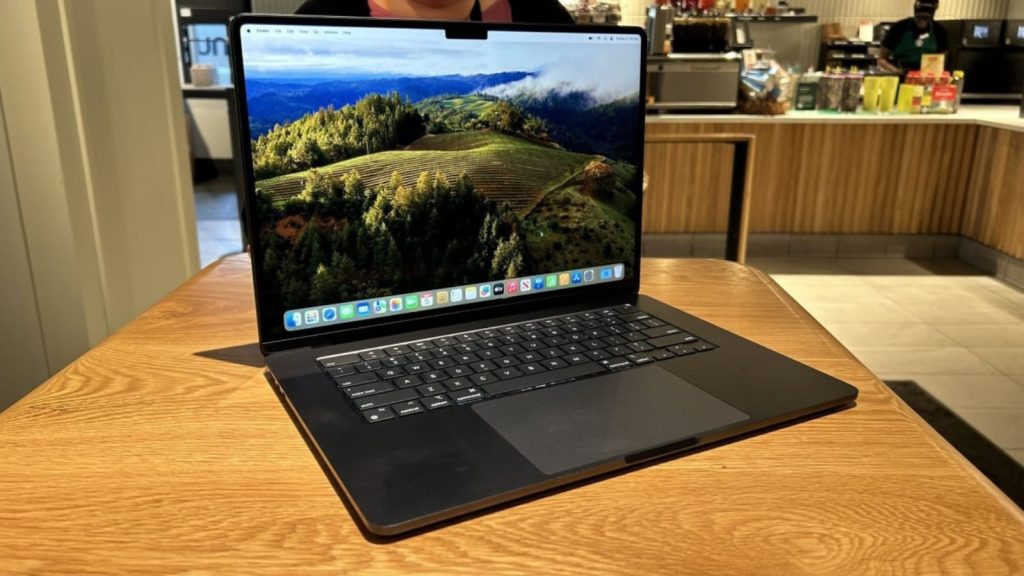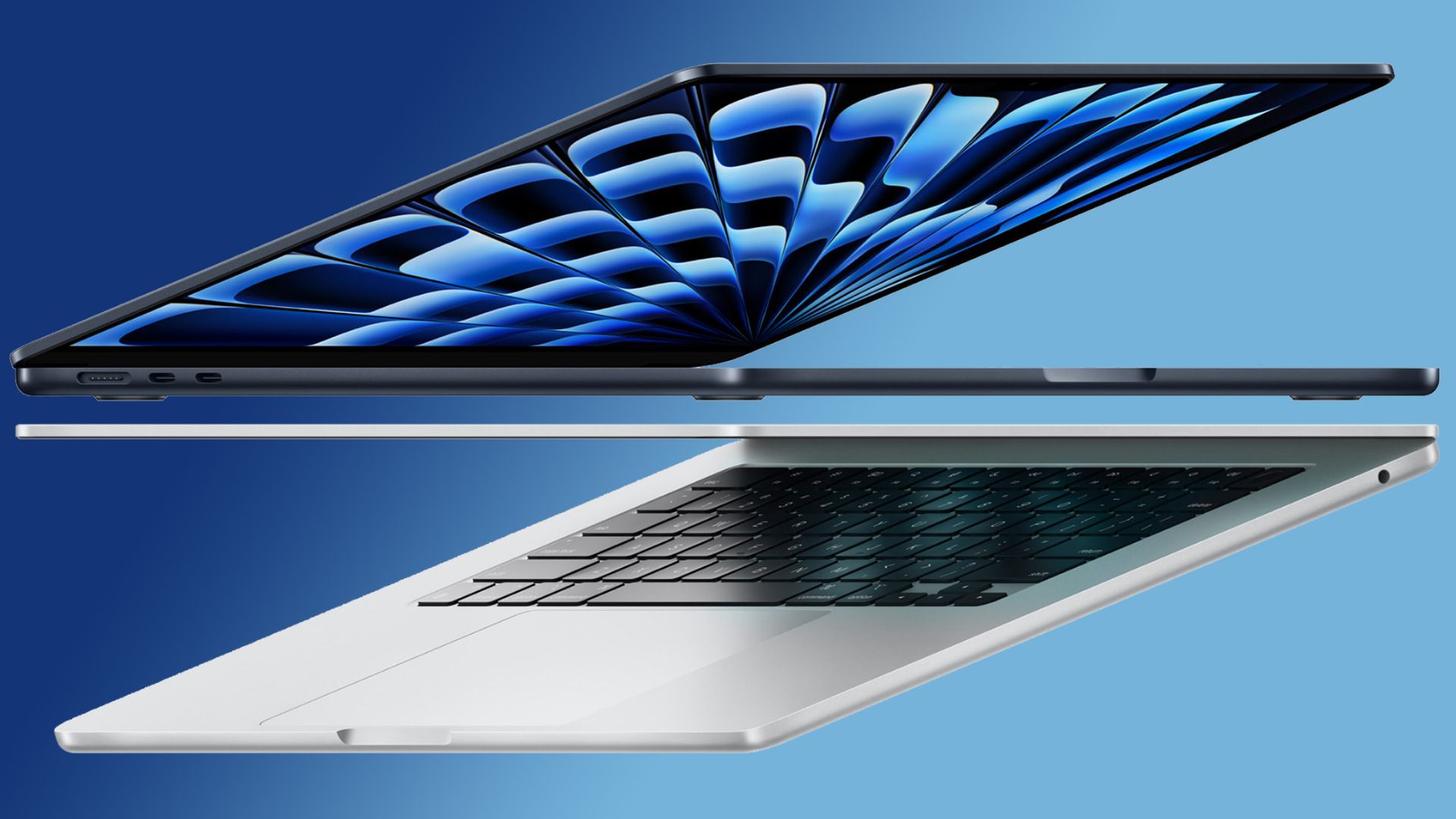Apple launched their new M3 MacBook Airs; there’s a 13-inch model, and this is their 15-inch model. But despite being what many would argue to be the best laptop in this segment, there were a lot of concerns and complaints that kind of bubbled up right at the announcement. Like, when I tweeted about it, there were just people that were, I think, legitimately concerned about it, but there’s also stuff that seems a little bit misguided, and I kind of want to go through it.
So, right off the rip, this is the M2 MacBook Air in a 13-inch model, and this is the M3. And the surface anodization on the new M3 versions, at least in the darker colors, so the midnight color and the space black, are supposed to have this seal to them, like a kind of coating over it to prevent fingerprints or to kind of reduce the presence of fingerprints. And when I tested it on the Space Black model last year, it seemed pretty noticeable. But for whatever reason, I’ll just demonstrate real quick. So this is the M21. When I smudge it around my nose and my face, which is disgusting, but just to get the point across, the grease appears, right? There’s a kind of smudge that appears. If I did the same thing on the new one, I would have imagined that it would be much more reduced, but I feel like there’s not much of a difference. And I was surprised. I mean, look at me. I’m rubbing laptops on my face here, but I was surprised at how present these smudges were. And I don’t know if it got a lemon or something, but when I try to clean it off, it seems just as smudgy. So my impression is that it is slightly better than the non-sealed version, but it’s not like fingerprint-proof material if that’s what you’re hoping for. Okay, onto the actual meat of this article.
All right, first, I want to talk about what I think is the biggest change or update to the M3 product. It’s the ability of the M3 MacBook Air to be able to connect to two external displays. Now, to be able to pull this off, the lid has to be closed. You cannot use the built-in laptop screen. It’s just that you’re connecting two screens. It’ll now work if you do want to use the built-in laptop screen. You’re back down to just one external display, just like the M1 and M2 MacBook Airs. Now, when this feature was announced, I think a lot of people were disappointed because they were like, How is this announcement like there’s so many Windows laptops out there that can run three or four screens concurrently and even The previous generation of MacBook Airs, like the Intel-based ones, could run two external screens with its internal laptop screen. Running like what gives what’s going on here? Well? I think it’s just the nature of these chips. These m1, m2, and m3 are like the base models of those chips. They’ve always only had one display controller that would handle the external displays. It was just like one single controller that could handle a 6K output for externals, which is what I think they’re doing now on the M3 MacBook Air. I think they’re just rerouting the internal 5K display controller and just pumping it out. There’s no like malice or like bizarre Trickery is going on; that’s just the nature of the hardware; you cannot have more than those two displays running at any given time. And I’d see the complaints like that. There’s that’s just the way the hardware is now, that being said. I think that there’s some kind of trickery going on. Back in the day, as in, when I think about what’s happening here It doesn’t make sense for Apple to just give out free features like this. That’s just that Apple’s not in the business of doing that, right? I think what happened was that Apple felt pressured to do this by its enterprise clients. For a lot of people, I know several high-end clients that purchase Apple hardware, and they hold back from Apple Silicon. They continued to use their Intel-based MacBooks because those things could run two external screens, no problem. And I think Intel banked on enterprise clients to be able to just pay a premium and buy into that pro lineup to get that extra screen external stuff. And I don’t think people wanted to spend that money. And I think Apple felt pressure. They’re like, you know what? I think we have to do this if we’re going to get a lot of enterprise clients to switch over to Apple Silicon. I think that’s the only thing that makes sense to me. Why else would they do this? Right? This seems too good for Apple’s nature to be true. But I think it’s a win.

I don’t think it’s perfect. But having two external displays on an entry-level MacBook Air is not bad, but you The second point of contention is the starting configuration of 8GB of RAM and 256GB of storage. I hate it. Every time I see it, it bothers me. Now, there’s two issues at hand here. First is the whole idea that the starting configuration is only 8GB of RAM, but the second issue is the price of the upgrades. Now, I’m going to address the 8GB of base RAM first. I don’t think that that number is terrible, in the sense that there are a ton of people—I would say the vast majority of people—that even consider this machine. They’ll be perfectly good with 8 gigs of RAM for like 5–6 years and would never notice any difference in the workflow if they had 16 gigs of RAM. I firmly believe that I’ve done a lot of testing. I’ve shown it to you guys. I think there’s a lot of stuff like clickbait YouTube out there that tries to build the idea that you absolutely need 16 gigs of RAM. But RageBait doesn’t take away from the reality of data if you’re using it for regular use. 8 gigabytes of RAM is plenty for the vast majority of people. But the other issue at hand is the cost of the upgrades, and I wouldn’t be having this super sweaty conversation about RAM on a MacBook if it weren’t for the fact that they have crazy pricing for those upgrades, like going from 8 gigs of RAM to 16 for $200. I actually think it’s like five times the industry price for RAM upgrades at this point. But because it’s all baked in, you have to make that decision up front now, if you think about the math. It’s like literally 20% more money to go for an extra 8 gigs of RAM. It’s so stupid, it eats my soul every time I look at the configuration pricing. But I think there’s a bit of a solution here. I think for most people that are looking at that, like the price configurator, they’re like, wow, that is a stupid amount of money, and it is, but usually you’re like, on a hard budget, you’re like, I have 1,100 bucks or whatever, 1,200 bucks, and that’s my limit. I don’t want to go any further than that. So, like, what do I do? And the simple solution this time is that you don’t get the M3 because they have a great product, the M2. That’s a hundred bucks cheaper, and if you get it on refurb or used, it’s even more; you can get like 15 to 20 percent off.
Just by going to the previous generation, if you want to save even more money The M1 MacBook Airs are even cheaper, which leads me to the conversation about that mild performance gain over the years from M1 to M3 because that has been another complaint that we keep seeing pop up. It’s like, wow, these new chips aren’t that much better. Absolutely, they aren’t, but that’s kind of a good thing, right? In terms of pricing, when they release this M3 product, they have to reduce the price of the older one, and if the gains aren’t massive, which they aren’t, just buy the old one. I think in all my years doing YouTube, I don’t think I’ve ever made a video where I was like, Don’t buy the new one, buy the old one, because that’s normally like common sense, right? You want the best value; the previous generation is always going to be that case, so I don’t even bother with that. But think about this particular timing of this time period: because the M2 and M1s were so close in performance to the M3, and they’re that much cheaper, and Apple has a refurb store that has steeper discounts, it just doesn’t make sense to buy the M3 product if you’re on a tight budget, unless you need the double external screen. Now that the CPU gains since M1 have been limited, the gains when it comes to graphics performance are more noticeable; it’s just that it’s quite dependent on the application that you’re using. Now the battery life on the M3 MacBook Air 15 is really similar to the M2 product from last year. It’s just that it seems to drain a little faster on heavier loads. But I think in general, when you look at Apple’s website, there’s a reason why they’re comparing a lot of this performance on the M3 MacBook Air products to Intel products, just because that’s where you’re going to notice the biggest gains now in terms of gaming. This is a fanless system, so keep that in mind, but This can run some pretty demanding games at lower settings. But in general, you’re going to want to be playing some really light titles. Now, the last thing I want to talk about really briefly is the mention of AI in Apple’s marketing material. So they talked about running LLMs and diffusion models on the M3 MacBook Air, and it’s legit.
Even though they don’t use Nvidia’s CUDA, Apple Silicon is fairly effective at handling that type of workflow. Now, just to wrap this off, the internals of this device haven’t changed, right? Like nothing, when I say internals, I mean like the screen and the keyboard. This is still a class-leading keyboard. The speakers are unchanged; these sound really good, especially for a device that’s super thin like this. On the screen, it goes up to 500 nits. This is a solid screen. I mean, obviously, the exposure of the camera is kind of portraying a brighter image than it actually gets up to; it is capped at 60 Hz, if that matters to you. It is like the thing that I believe Apple uses to just kind of separate the pro products from the amateur products. That refresh rate. Okay, there you have it, the M3 MacBook Air.



